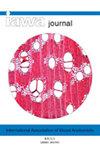用于测量木材中细胞尺寸、细胞塌陷和空间关系的镶嵌、块面显微镜
IF 3.5
3区 农林科学
Q2 FORESTRY
引用次数: 1
摘要
传统的立体光学显微镜被用来成像抛光木材表面在细胞分辨率超过生长环或更大的尺度。使用带通滤波和局部对比度增强来辅助图像的自动阈值化和二值化。提出了一种基于未塌陷细胞腔间距离的细胞塌陷位置和比例估计方法。此外,利用欧几里得距离变换确定了血管之间的空间关联。对树皮和髓核的分析提供了足够的细节来显示辐射松管胞尺寸(壁厚、壁面积和径向宽度)的年际变化趋势。这些趋势与预期一致,与文献一致。由于干燥,测量的细胞尺寸可能会受到细胞坍塌和变形的影响。对风干、窑干和烘干桉树的分析表明,细胞塌陷变化很大,但一般在生长环的外三分之一处更为突出。在生长环上,导管形状发生了显著变化,导管面积因干燥而显著减小。该技术在详细显微镜和宏观成像之间提供了一个中间步骤,允许在木材细胞水平上进行空间分析。本文章由计算机程序翻译,如有差异,请以英文原文为准。
Mosaic, block-face microscopy for measuring cell dimensions, cell collapse, and spatial relationships in wood
A conventional stereo light microscope was used to image polished wood surfaces at cellular resolution over size scales of the growth ring or larger. Bandpass filtering and local area contrast enhancement were used to aid automatic image thresholding and binarisation. An estimate for the location and proportion of cell collapse was introduced based on the distance between uncollapsed cell lumens. Additionally, spatial associations between vessels were determined using a Euclidean distance transform. The analysis of pith to bark cores provided sufficient detail to show significant intra and inter-annual trends in Pinus radiata tracheid dimensions (wall thickness, wall area, and radial widths). These trends were consistent with expectations and in agreement with the literature. Measured cell dimensions may be influenced by cell collapse and deformation as a result of drying. The analysis of air, kiln and oven-dried Eucalyptus nitens showed that cell collapse was highly variable but generally more prominent in the outer third of growth rings. There were significant changes in vessel shape across the growth rings and vessel area was significantly reduced by drying. The technique provides an intermediate step between detailed microscopy and macroscopic imaging that allows spatial analysis at the wood cell level.
求助全文
通过发布文献求助,成功后即可免费获取论文全文。
去求助
来源期刊

IAWA Journal
农林科学-林学
CiteScore
3.40
自引率
15.80%
发文量
26
审稿时长
>36 weeks
期刊介绍:
The IAWA Journal is the only international periodical fully devoted to structure, function, identification and utilisation of wood and bark in trees, shrubs, lianas, palms, bamboo and herbs. Many papers are of a multidisciplinary nature, linking
 求助内容:
求助内容: 应助结果提醒方式:
应助结果提醒方式:


